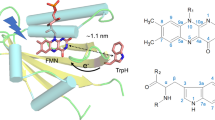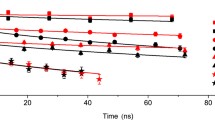Abstract
Displacement of particles from the purified light-harvesting chlorophyll a/b protein aggregate (LHC) was studied in magnetic fields of various strengths (0 to 1.6 T) by polarized fluorescence measurements. Macromolecular aggregates of LHC have a considerable magnetic susceptibility which enables the particles to rotate and align with their nematic axes parallel with H. As LHC is embedded in a transmembrane direction thylakoids should align perpendicular to H, the mode of alignment experimentally observed in thylakoids. The value of the magnetic susceptibility could be estimated by relating it to the integral susceptibility of the chlorophyll molecules in LHC. The fitting of this value with the field strength dependency of the fluorescence polarization ratio (FP) revealed a relationship between the LHC content of various photosynthetic membranes and their capacity for alignment, which suggested that LHC might be the torque ordering chloroplasts in a magnetic field.
Similar content being viewed by others
Abbreviations
- LHC:
-
light-harvesting chlorophyll a/b protein
- FP:
-
fluorescence polarization ratio, Iz/Iy
References
Anderson, JM and Boardman, NK (1966) Biochim Biophys Acta 112, 403–421
Argyroudi-Akoyunoglou, J and Akoyunoglou, G (1973) Photochem Photobiol 18, 219–223
Bialek, GE, Horváth, G, Garab, GyI, Mustárdy, LA and Faludi-Dániel, Á (1977) Proc Natl Acad Sci USA 74, 1455–1457
Burke, JJ, Ditto, CL and Arntzen, ChJ (1978) Arch Biochem Biophys 187, 252–263
Faludi-Dániel, Á and Mustárdy, LA (1983) Plant Physiol 52, 54–56
Garab, GyI, Kiss, JG, Mustárdy, LA and Michel-Villaz, M (1981) Biophys J 34, 423–437
Geacintov, NE, Van Nostrand, F, Becker, FF and Tinkel, JB (1972) Biochim Biophys Acta 267, 65–79
Gregory, RPF, Demeter, S and Faludi-Dániel, Á (1980) Biochim Biophys Acta 591, 356–360
Keszthelyi, L (1980) Biochim Biophys Acta 598, 429–436
Knox, PS and Davidovich, MA (1978) Biophys J 24, 689–712
Kyle, DJ, Ting-Yun Kuang, Watson, JL and Arntzen, ChJ (1984) Biochim Biophys Acta 765, 89–96
Li, J (1985) Proc Natl Acad Sci USA 82, 386–390
Papp, E and Meszena, G (1982) Biophys J 39, 1–5
Saeva, FD (1979) In: Liquid Crystals (Saeva, FD ed) Marcel Dekker Inc New York pp 249–273
Williams, R (1974) In: Liquid Crystals and Plastic Crystals Vol. 2 (Gray, CW and Winsor, PA eds) J Wiley New York, London, Sidney, Toronto pp 110–122
Zimányi, L and Garab, GyI (1982) J Theor Biol 95, 811–821
Author information
Authors and Affiliations
Rights and permissions
About this article
Cite this article
Kiss, J.G., Garab, G.I., Tóth, Z.M. et al. The light-harvesting chlorophyll a/b protein acts as a torque aligning chloroplasts in a magnetic field. Photosynth Res 10, 217–222 (1986). https://doi.org/10.1007/BF00118286
Issue Date:
DOI: https://doi.org/10.1007/BF00118286




